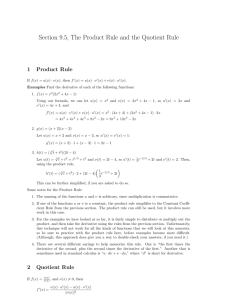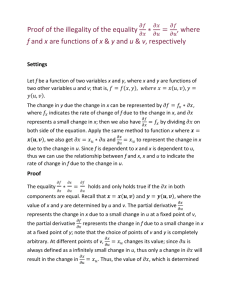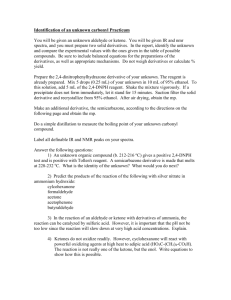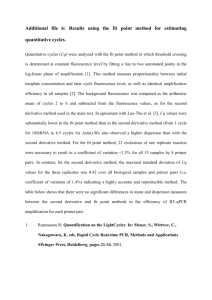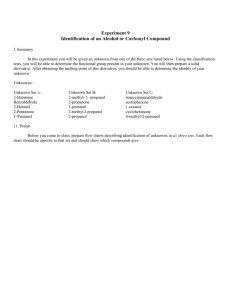Chapter 4 Calculating the Derivative
advertisement
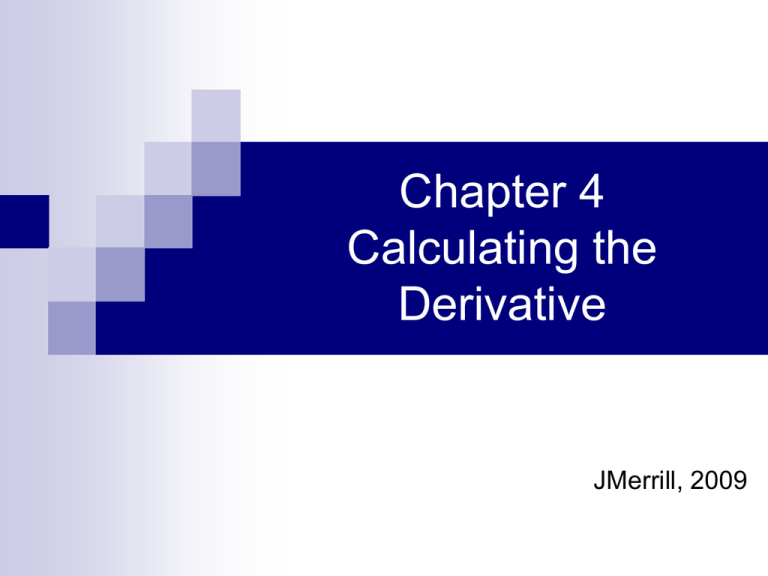
Chapter 4 Calculating the Derivative JMerrill, 2009 Review Find the derivative of (3x – 2x2)(5 + 4x) -24x2 + 4x + 15 Find the derivative of 2 5x 4 x 5 2 (x 1) 2 5x 2 x 2 1 4.3 The Chain Rule Composition of Functions A composition of functions is simply putting 2 functions together—one inside the other. Example: In order to convert Fahrenheit to Kelvin we have to use a 2-step process by first converting Fahrenheit to Celsius. 5 C (F 3 2) o o 89 F = 31.7 C 9 K C 273 31.7oC = 304.7K But if we put 1 function inside the other function, then it is a 1-step process. Composition of Functions The composite of f(x) and g(x) is denoted f which means the same as f(g(x)). g x We are used to writing f(x). f(g(x)) simply means that g(x) is our new x in the f equation. We can also go the other way. g f x means g(f(x)). Given f(g(3)) = = f(6) = 4(6)2 – 2(6) = 144 – 12 = 132 f ( x) 4 x 2 x 2 g(3) = 6 g ( x) 2 x Given f f ( x) 1) ff ((xx 1) g (x) x 1 x g g x ff ((gg((xx)))) 1 g(x) = x+1 1 f x g ( f ( x )) 1 g x x 1 1 1 x Substitute x+1 In place of the x in the f equation The new x in the g equation = The Chain Rule Chain Rule Example Use the chain rule to find Dx(x2 + 5x)8 Let u = x2 + 5x Another way to think of it: The derivative of Let y = u8 dy dy du dx du dx 8u 7 the outside times the derivative of the inside 2 x 5 2 8 x 5x 7 2x 5 Chain Rule – You Try Use the chain rule to find Dx(3x - 2x2)3 Let u = 3x - 2x2 Let y = u3 The derivative of the outside times the derivative of the inside dy dy du dx du dx 3u 2 3 4 x 3 3x 2x 2 2 3 4 x Chain Rule Find the derivative of y = 4x(3x + 5)5 This is the Product Rule inside the Chain Rule. Let u = 3x + 5; y = u5 4 5 4 x 5u (3) (3x 5 ) ( 4 ) 4 5 4 x 5(3x 5 ) (3) 4(3x 5 ) 4 x 15(3x 5 ) 4 4 4(3 x 5 ) 6 0 x(3x 5 ) 4(3x 5 ) 5 5 Chain Rule 6 0 x (3x 5 ) 4 4 (3x 5 ) 5 F a c to r o ut th e c o m m o n f a c to r 4 4 (3x 5 ) 1 5 x (3x 5 ) 4 4 (3x 5 ) (18 x 5 ) Chain Rule 3x 2 7 Find the derivative of x 1 This is the Quotient Rule in the Chain Rule Let u = 3x + 2; let y = u7 6 7 ( x 1) 7 u (3) (3x 2) (1) ( x 1) 2 6 7 ( x 1) 7 ( 3x 2) (3) (3x 2) ( x 1) 2 6 7 2 1 ( x 1)(3x 2) (3x 2 ) ( x 1) 2 Chain Rule 7 6 2 1 ( x 1)(3x 2) (3x 2) ( x 1) 2 F a c to r o ut th e c o m m o n f a c to r 6 (3x 2) 2 1( x 1) (3x 2) ( x 1) (3 x 2 ) 6 2 1x 2 1 3x 2 ( x 1) (3x 2) 6 2 2 18 x 2 3 ( x 1) 2 4.4 Derivatives of Exponential Functions Derivative of ex Derivative of ax x Dx 3 (l n 3)3 x Other Derivatives Examples – Find the Derivative y = e5x e g( x ) e 5x (g '(x ) (5) 5 e 5x Examples – Find the Derivative y = 32x+1 g( x ) g '( x ) 2x 1 (2) ln a a ln 3 3 2 ln 3 3 2x 1 Example dy 2 x 1 Find if y e 5x 2 dx Use the product rule y e x 2 1 1 x2 1 Dx 5 x 2 2 5 x 2 Dx e 1 1 2 5 x 2 2 (5 ) x 1 e (2x ) 2 5 2 5x 2 Example y e e 2 x 1 1 Dx 5 x 2 2 5 2 x 1 2 5x 2 5e 2 x 1 2 5x 2 5 x 2 Dx 2 x 1 5 x 2 2x e 2 x 1 5 x 2 2x e x2 1 e Example Continued 5e 2 x 1 2 x 1 2xe 2 5x 2 5e 2 x 1 e 2 x 1 ( 4 x )(5 x 2) 2 5x 2 e 2 x 1 5 4 x (5 x 2) 2 5x 2 e 2 x 1 2 5x 2 5x 2 2 5x 2 2 20 x 8x 5 2 5x 2 Get a common denominator to add the 2 parts together 4.5 Derivatives of Logarithmic Functions Definition Bases – a side note Everything we do is in Base 10. We count up to 9, then start over. We change our numbering every 10 units. 1 11 21 Two tens 2 12 22 and 3 13 23… One Ones …one group of Place 4 14 s ten and 5 15 1, 2, 6 16 3…ones 7 17 8 18 9 19 10 20 Bases The Yuki of Northern California used Base 8. They counted up to 7, then started over. The numbering changed every 8 units. 1 13 25 Two eights 2 14 26 and One 3 15 27… Ones …one eight Place 4 16 s and 5 17 3…ones 6 20 7 21 So, 17 in Base 8 = 15 in Base 10 10 22 11 23 258 = 2 eights + 5 ones = 21 12 24 Bases The Mayans used Base 20. The Sumerians and people of Mesopotamia used Base 60. Definition Example Find f’(x) if f(x) = ln 6x Remember the properties of logs ln 6x = ln 6 + ln x d dx (ln 6) 0 1 x d dx 1 x (ln x ) Definitions Examples – Find the Derivatives y = ln 5x If g(x) = 5x, then g’(x) = 5 dy dx g '(x ) g(x ) 5 5x 1 x F’(x) f(x) = 3x ln x2 Product Rule d 2 2 f '( x ) (3x ) ln x ln x (3) dx 2x 2 3x 2 ln x (3) x 6 3 ln x 2

